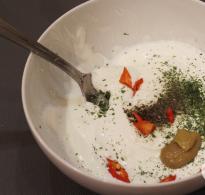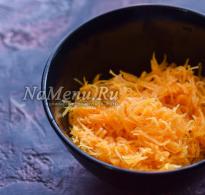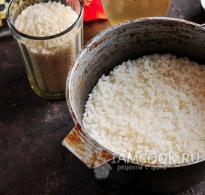What is the name of the mushroom with a white cap? The real king of mushrooms: description and value of the handsome boletus
White mushroom - is probably one of the most desirable in a mushroom picker’s basket. Its value lies in its high taste and ability to be used in various types of processing. You can dry, freeze and pickle, and these are not all the ways to prepare dishes with the “king” mushroom. Residents of Eastern European countries consider it the best of all mushrooms for its taste qualities. Sometimes people call him “the king of mushrooms.”
The pulp is strong, juicy, fibrous in older specimens, white in young mushroom, turns a little yellow with age. Does not change color after cutting, but there is a slight change in color to pink or blue. Under the dark skin there may be a layer of brown or red-brown tint.
The taste of porcini mushroom is very mild and weakly expressed. Characteristic of many types of mushrooms, the smell of raw pulp is faintly noticeable. A very strong, pleasant and persistent mushroom smell appears during cooking and especially during drying.
Porcini mushrooms in the forest
Most often they grow in deciduous, coniferous and mixed forests. Fruits in waves (in the first ten days of June, then in mid-July, in August). The first wave is usually accompanied by a not very abundant harvest, but the next “wave” very often differs in harvest from all the others. In warmer regions it appears briefly at the end of May. Porcini mushroom can be collected from Karelia to Primorye, from the second half of June to November. There are about 50 tree species with which mushrooms form mycorrhiza, but more often they enter into symbiosis with birch, oak, pine, spruce, beech and hornbeam.
Among similar species, the following species can be distinguished porcini mushrooms:
Spruce porcini mushroom- has a wider distribution, it has an elongated leg that thickens at the bottom. The mushroom cap is brown with a reddish or chestnut tint, smooth, dry. Usually found in fir and spruce forests, it can be found in all places where the porcini mushroom is distributed, with the exception of Iceland. Season from June - October.
White oak mushroom- it is distinguished by a brown cap, which has a grayish rather than brown tint, sometimes with light spots. The pulp, unlike other porcini mushrooms, is looser. They are found in oak forests from June to October, in the vast expanses of the central and southern zone of the European part of Russia, in the Primorsky Territory and in the Caucasus.
White birch mushroom It is distinguished by its cap, which is light, almost white. It can mainly be found under birch trees.
White pine mushroom has a large dark cap, rarely with a purple tint. The pulp is brownish-red.
White mushroom reticulate has a light-colored brownish or ocher cap and a short cylindrical stem, very similar to a moss fly. It grows more often with beech and hornbeam trees. Found in Transcaucasia, Europe, North Africa and North America. Season from June to September, not often and not abundantly.
You liked it! Then click on the button
Type of porcini mushroom (also known as boletus mushroom, cow mushroom) - edible, tubular mushroom, which belongs to the Borovik genus. Its appearance is significantly influenced by environmental conditions, but despite this, the porcini mushroom always looks like a handsome giant compared to its other relatives.
The most common inhabitant of spruce and fir forests has a brown, smooth, dry cap with a reddish or chestnut tint, and a long stem, widened towards the bottom.
An abundance of brown caps with a grayish tint are found in oak forests, hence the clarification in the name oak porcini mushroom.
The proximity of birches makes the cap of the boletus light, almost white, and thanks to its proximity to pine trees, its cap is large, dark with a purple tint and brownish-red flesh under the skin.
Boletus can also have a cap that is bright yellow, purple, orange-red, light brown, black-brown, light bronze or ocher. But such specimens are not very common.
Photo of white mushroom
Structure
Mature individuals are characterized by a convex cap with a smooth or wrinkled surface. The hat is sticky during wet weather and looks disgusting; It is matte in dry, sunny weather. The skin does not separate from the pulp.
In young individuals, the juicy, dense pulp is always white, while in older mushrooms it has a yellowish tint, and just under the skin there may be a small layer of red-brown tint. Many people are interested in whether the porcini mushroom turns blue when cut. It is believed that this type does not differ in this property.
Porcini mushroom in its raw state has a faint odor and only during the cooking process does a pleasant mushroom aroma appear.
The leg of the boletus is massive, club-shaped and with a whitish surface, which can also take on a slight shade of the cap. At first, the white tubular layer gradually turns yellow and in mature individuals turns into an olive green color. Boletus spore powder is olive-brown in color.

Habitats
Boletus likes mature and old forests with an abundance of moss and lichens, but it also feels great on sandy, sandy loam, and loamy soils. The white mushroom is common on all continents except Australia.
Warm, foggy nights and short heavy rains, especially in the second half of August, are ideal weather conditions when whites delight a huge amount. Boletus is found from June to September.

Some general information
Why are these mushrooms called porcini? There is no reliable answer to this question. The most common theory is that the porcini mushroom retains its color white during processing; most other mushrooms tend to darken or turn brown.
In the summer, the life cycle of the porcini mushroom lasts 6–9 days, and already in September it increases from 9 to 15 days, but during this time it reaches impressive sizes compared to other mushrooms, which ripen in approximately 3–5 days.
Despite its large shape and wide distribution, the boletus is very skillfully hidden from view, so searching for it requires patience and perseverance. The best specimens to collect should have a cap diameter of approximately 4 cm.
Description of storage methods fresh mushrooms boils down to the fact that boletus mushrooms must be processed immediately, otherwise after 10 hours they will lose their beneficial properties.
Due to their unprofitability, porcini mushrooms are not cultivated industrially, but amateur mushroom growers conduct similar experiments.
The porcini mushroom is considered the king of mushrooms not only because of its impressive size, but also because of its taste and nutritional value. Another name for the porcini mushroom is boletus, less commonly, cow mushroom. It grows mainly in Eurasia and North America, and is sometimes found in Syria and Lebanon.
The porcini mushroom can reach enormous sizes - caps up to 50 cm in diameter and legs up to 25 cm in height. So why is it called white? The fact is that, unlike other “black” mushrooms, it does not change its color when cut, cooked and dried. The rest of the mushrooms darken, turn brown or even turn black.
Porcini mushrooms are valued for their taste and nutritional properties. At proper preparation porcini mushroom is a real delicacy.
This mushroom belongs to the first category mushrooms. This means that it is absorbed by the human body better than other mushrooms, and this is undoubtedly much more important than just the content of useful substances. But porcini mushrooms are fine with this too.
Porcini mushrooms contain more riboflavin than others, a substance responsible for the health and growth of nails, hair, skin and the health of the body as a whole. Riboflavin is especially important for maintaining normal thyroid function.
Dried porcini mushrooms contain the alkaloid hercedine, which is used in the treatment of angina pectoris.
IN Russian forests The porcini mushroom is found frequently, in some places even abundantly. It grows mainly in birch, pine, oak and hornbeam forests and is very fond of sandy soil in pine forests. Grows in groups or singly.
According to the place of growth, the porcini mushroom is divided into:
White birch mushroom
It is distinguished by its light-colored cap, sometimes almost white. The mushroom grows in birch groves, on forest edges, along forest roads, but always under birch trees.The first mushrooms appear when the rye begins to spike, so in some areas middle zone In Russia they are also called spikelets.
The first mushrooms usually stand alone among young grass; from mid-summer they are found in groups. The stem of the mushroom is thick and short.
White pine mushroom
 Other names for this mushroom: pine, boletus.
Other names for this mushroom: pine, boletus. Habitat: pine porcini mushroom, as its name suggests, grows almost exclusively under pine trees, loves white moss and sandy soils, and is found quite often.
There are two main “layers” of these mushrooms: the first in June, and then the second, more abundant one in the fall.
Spruce porcini mushroom
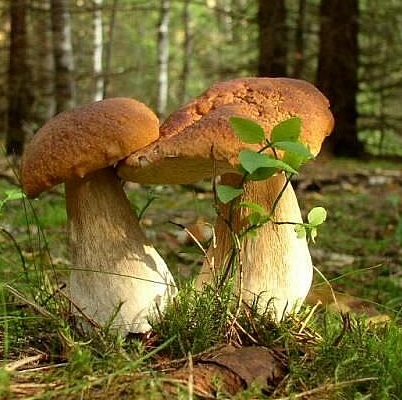 Habitat: spruce porcini mushroom grows in spruce and mixed with spruce forests, singly or in small groups, from July to October. The time of main growth is from the end of August. Its cap rarely reaches a diameter of 20 cm. The surface of the mushroom cap is usually uneven, lumpy, unevenly colored (there are darker and lighter areas), the color of the cap is brownish or brownish-brownish.
Habitat: spruce porcini mushroom grows in spruce and mixed with spruce forests, singly or in small groups, from July to October. The time of main growth is from the end of August. Its cap rarely reaches a diameter of 20 cm. The surface of the mushroom cap is usually uneven, lumpy, unevenly colored (there are darker and lighter areas), the color of the cap is brownish or brownish-brownish. Tubular layer at a young age white, turns yellow in adulthood. Pulp: dense, white, with a pleasant mushroom smell and sweetish taste, the color does not change at the break.
Olive spore powder. Leg: relatively long, up to 18 cm, strong. Young mushrooms have an impressive thickening at the base; sometimes the stem is very deeply immersed in the soft forest floor; the stem has a pattern in the form of a light mesh.
White oak mushroom
 The earliest type of porcini mushroom appears in May.
The earliest type of porcini mushroom appears in May. The cap of the white oak mushroom is initially grayish, later brown, light coffee-colored, smooth or wrinkled, gently velvety.
The mushroom bears fruit in layers until October. Loves deciduous forests with oaks and beeches, as well as hornbeams, lindens, in the south - with edible chestnuts.
Prefers a warm climate, more often found in mountainous and hilly areas.
White mushroom reticulate
 The cap is initially hemispherical, later strongly convex, with a diameter of 6-30 cm. The skin is light brown, matte, velvety, dry, and with age it can become covered with a network of cracks. The pulp is dense and fleshy, white, does not change when cut, and may acquire a yellowish tint under the tubes.
The cap is initially hemispherical, later strongly convex, with a diameter of 6-30 cm. The skin is light brown, matte, velvety, dry, and with age it can become covered with a network of cracks. The pulp is dense and fleshy, white, does not change when cut, and may acquire a yellowish tint under the tubes. It has a mushroom smell and a sweet or nutty taste. The leg is thick, fleshy, narrower in the upper part, brownish or brownish in color, covered with a large mesh pattern of lighter veins.
It often grows in forests with beech and hornbeam trees. Found in Transcaucasia, Europe, North Africa and North America. Season from June to September, not often and not abundantly.
_______________________________
The mass collection of porcini mushrooms in the European part of Russia begins in the second half of August and lasts until the first half of September, however, porcini mushrooms can be found at other times. Typically, porcini mushrooms are collected while they are not too large (with caps 5-10 cm in diameter).
Porcini mushroom, like all mushrooms of the first category, is actively used in cooking, both fresh (fried, boiled) and dried, salted and pickled. Dishes made from porcini mushrooms can be prepared without additional (or after a very short - 10-15 minutes) boiling. Since porcini mushrooms do not darken when processed, they are often used in soups, where they provide a clear, clean broth.
 If we talk about preparations for future use, then best method preserving porcini mushrooms - drying. It is in dried mushrooms that they are best preserved useful substances. The collected mushrooms are cleared of soil and debris. For large mushrooms, the stems are separated from the caps; if the mushrooms are very small, they are left whole.
If we talk about preparations for future use, then best method preserving porcini mushrooms - drying. It is in dried mushrooms that they are best preserved useful substances. The collected mushrooms are cleared of soil and debris. For large mushrooms, the stems are separated from the caps; if the mushrooms are very small, they are left whole.
You can dry porcini mushrooms in drying chambers or ovens. At the beginning of drying, a temperature of 50-60° is recommended, at the end - 70-80°. Mushrooms can be dried in dehydrators or ovens in 4-6 hours. Dried porcini mushrooms retain their taste and nutritional properties in the best way; they can be eaten as crackers without additional processing.
A wonderful, aromatic mushroom soup can be cooked in winter by first soaking the dried mushrooms in water for 20-25 minutes. Then boil a little in the same water, cut into the necessary pieces and add to the prepared dish. The water in which dried porcini mushrooms were soaked or boiled can be used for sauces.
In addition to drying, porcini mushrooms can be frozen (the second simple method after drying is for those who have freezers), as well as marinate and salt. Heat treatment of mushrooms for harvesting is, of course, good, but all the “salt” is in fresh mushrooms. Their aroma and taste are much superior to pickled and salted mushrooms. There are many folk and original recipes for dishes made from fresh porcini mushrooms. In addition to Russian cuisine, porcini mushrooms are very popular in French and Italian cuisine.
Recipes for dishes with porcini mushrooms
Mushroom soup (Russian folk recipe)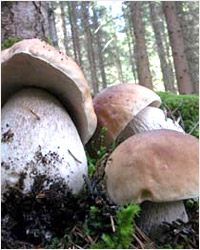 Ingredients:
Ingredients: 
1 cup pearl barley,
2-3 potatoes,
2-3 carrots,
1-2 onion heads,
250-300 g porcini mushrooms,
butter, sour cream,
herbs, seasonings and salt - to taste.
Preparation:
Pearl barley simmer for about 3-4 hours over low heat until the broth becomes thick. Cut the mushroom stems into slices and fry with onions over low heat. It is better to fry in a frying pan with thick walls to “simmer” the contents. Add some salt. 20 minutes before the end of cooking the cereal, add potatoes, carrots and cut into medium-sized pieces. mushroom caps. Then add the contents of the frying pan into the soup and cook for another 2-3 minutes. Add seasonings to taste. TO mushroom soup black allspice works well and bay leaf. Add a spoon butter. Cover with a lid and let sit for 20-30 minutes. Serve the soup in deep bowls, adding a spoonful of sour cream and sprinkling with parsley and dill.
Preparation:
Thaw white mushrooms and cut into pieces.
 Chop the leek and fry in half the heated olive oil in a saucepan until golden brown. Add porcini mushrooms and cook, stirring, for 6-7 minutes.
Chop the leek and fry in half the heated olive oil in a saucepan until golden brown. Add porcini mushrooms and cook, stirring, for 6-7 minutes. Cut the champignons into slices and fry separately in the remaining olive oil for 5-6 minutes.
Pour 1 liter of water into the pan with porcini mushrooms, add half the champignons and simmer over low heat for 10 minutes. Puree the soup in a blender, return to the pan, and bring to a boil. Add cream, salt, pepper and cook for another 4 minutes. Pour into plates and garnish with remaining champignons.
“Gribnitsa” (an old Russian recipe)
Ingredients:
approximately equal amounts of potatoes and porcini mushrooms,
butter, sour cream - to taste,
bay leaf, coriander, allspice - to taste.
Preparation:
Cut adult mushrooms (with slightly greened core) into cubes. Cut the potatoes into the same cubes. Place them in cold water, bring to a boil, add salt, add spices and cook until the potatoes are ready, plus another 10 minutes - the potatoes should soften a little. The resulting result in the form of a puree soup is served with pieces of butter and sour cream to taste. It is important to maintain strict minimalism in the recipe and not add onions or strong-smelling seasonings “for potatoes” or “for mushrooms”. What is important in this dish is the balance of mushroom and potato flavors.
Walnut and mushroom soup (Welsh recipe)
Ingredients:

Preparation:
Cook the mushrooms in the broth for 20-25 minutes, add the nuts and cook for another 15-20 minutes until the mushrooms soften. Cool and grind everything in a blender. Lightly fry the leeks in oil and add rice flour.
Stirring constantly, add the chopped nut-mushroom mixture and sherry and simmer for 15-20 minutes. At this point, the dish can be cooled and stored in the refrigerator for 2-3 days to smooth out the flavor. Next, add sour cream and heat over low heat, avoiding boiling. Before serving, decorate with nuts or herbs.
Alpine mushroom salad
Ingredients:
- 100 g porcini mushrooms,
- 200 g chanterelles,
- 1 tbsp. garlic,
- 100 g fresh tomatoes,
- 2 tbsp. fresh basil,
- 3 tbsp. olive oil,
- 3 tbsp. lemon juice,
- 1 tbsp. wine vinegar,
- parsley, dill - to taste.
Preparation:
Cut the mushrooms into cubes, the tomatoes into slices and remove the seeds. Preheat the oven, grease a baking sheet with olive oil, place mushrooms and garlic on it, stir and bake for 15-20 minutes until light brown. Let the mushrooms cool and mix with other ingredients.
Crispy porcini mushrooms Italian style
Ingredients: 
fresh porcini mushrooms, flour, olive oil, salt.
Preparation:
Cut large mushrooms into slices, and small ones can be whole. Roll them in flour.
To moisten the flour and crisp up the mushrooms, dip each slice in cool water and fry in hot oil until golden brown.
Dry the mushrooms in absorbent paper, add salt and serve hot.
Mushroom fondue Italian style
Ingredients:
- 200 g dry white wine,
- 100 g Marsala wine,
- 200 g dried porcini mushrooms,
- 400-450 g various cheeses(parmesan, fontina, emmenthaler),
- 2-3 tbsp. flour,
- 1 clove of garlic,
- black pepper to taste.
Preparation:
Heat Marsala to a boil, pour over dried mushrooms and leave for an hour. Grind the cheeses and mix with flour. Rub enamel pan or garlic fondue pot, pour white wine into it and place on low fire. When the wine is almost boiling, add the cheese in small portions, making sure it has time to melt before adding the next portion.
Squeeze the mushrooms from the wine and cut them into small pieces. Add mushrooms and freshly ground pepper to the fondue. Serve the fondue with several types of bread and sausages.
How to fry porcini mushrooms with onions
Ingredients: 2 onions, 300-500 g mushrooms, black pepper, salt, 3 tbsp. spoons of vegetable oil.Rinse the sorted mushrooms, pour boiling water over them and cut into slices along the stem. Then salt and pepper them. Place the mushrooms in a heated frying pan with vegetable oil. Fry them for 10-15 minutes, stirring gently. Meanwhile, fry the onion sliced into rings until golden brown in a separate frying pan. Mix fried porcini mushrooms with fried onions and serve.
How to fry porcini mushrooms with sour cream
Ingredients: 1 teaspoon of flour, 0.5 cups of sour cream, 300-400 g of porcini mushrooms, 3 tbsp. spoons of vegetable oil.Fry the mushrooms as in the recipe with onions, and when the mushrooms turn golden, add flour and sour cream to the pan with the mushrooms and stir. Bring the mushrooms with sour cream to a boil and fry over low heat, stirring, for another 5-7 minutes.
How to dry porcini mushrooms
To do this, the mushrooms are not washed, but only cleaned of debris and cut lengthwise into two or more parts (this depends on the size of the mushroom). Dry in the oven on a wire rack at a temperature of 50–70 degrees for 7–12 hours. They should be stored in a dry place tightly closed container. Dried porcini mushrooms retain their taste and nutritional properties in the best way; they can be eaten as crackers without additional processing.The biggest advantage of dried porcini mushroom is that it can be cooked all year round, namely: cook soups, fry, use as a filling for pies. Since when dried, the porcini mushroom does not lose its beneficial properties and unique aroma.
For soups, dried mushrooms are soaked in warm water, washed and soaked in a second water until completely swollen. After this, the mushrooms are cut into small pieces, and the water is used for broth.
How to pickle porcini mushrooms
Ingredients: 1.5 kg of porcini mushrooms; 1 liter of water; 1.5 – 2 tbsp salt; 1 tbsp. spoon granulated sugar; 2-3 bay leaves; 4-6 peas allspice; 1 teaspoon – 70-80 percent vinegar essence; a little clove.Cook the washed porcini mushrooms in a saucepan for about 15-20 minutes. Drain the water. Pour boiling marinade of water, salt, sugar and vinegar over the mushrooms. Cook the mushrooms in the marinade for another 3-5 minutes.
Add black pepper - peas, bay leaf, cloves - to a dry, prepared, sterilized jar. You can add garlic, basil, parsley and other spices and herbs.
Carefully transfer the mushrooms into a jar and pour in the marinade, and close the jar tightly.
How long to cook porcini mushrooms
Fresh porcini mushrooms are cooked for 15-20 minutes until tender. Dried porcini mushrooms must be soaked in water for several hours before cooking. cold water, and then cook until they settle. Place frozen mushrooms in boiling water and cook for 20 minutes.Calorie content and nutritional value of porcini mushrooms
The calorie content of porcini mushrooms is 34 kcal. Nutritional value porcini mushrooms: proteins - 3.7 g, fats - 1.7 g, carbohydrates - 1.1 gWhite mushroom, boletus (aka royal mushroom or king of the forest) - valued by lovers " quiet hunt"for the pleasure that can be obtained in the process of collecting it. Housewives love it for its extraordinary taste properties and the variety of dishes to which it is able to convey its unique taste. The white mushroom is not alone, it has big family, many relatives united into a whole species. How then can you determine, without making a mistake, whether this is the copy you need? And how to distinguish false mushroom from the present? To figure out what this mushroom looks like and how to identify it, a description will come to the rescue.
The cap and stem of the porcini mushroom, the fruiting body, are fleshy, dense, and large. The size of the upper part ranges from 6 to 25 cm. In young people it resembles a hemisphere, in mature ones it is more flattened. The surface can be different: wrinkled, smooth, velvety; at high humidity it is covered light layer mucus.
The hymenoflor (the layer under the cap containing pores) usually easily detaches from the mass of the upper part. Disputes can be like different shapes, as well as color and size. What the color of the crown will be depends on the forest in which the mushroom grows:
- in the oak forest the cap is pale, whitish;
- in pine it is dark brown;
- in spruce it is almost black;
- in deciduous light.
The leg (4 to 10 cm high, 2-5 cm in diameter) has a thickening in the middle or downwards. The surface is covered with a relief mesh pattern, less often with dots. The flesh of the mushroom may be yellow, turning blue when cut.
Why is the porcini mushroom called white?
 There is no clear explanation for why it is called white and the time of origin of the name. In the old days, the concept of “mushrooms” included all edible representatives of this genus. Dahl's dictionary provides an interpretation of “white”, contrasted with “black”, less valuable tubular ones.
There is no clear explanation for why it is called white and the time of origin of the name. In the old days, the concept of “mushrooms” included all edible representatives of this genus. Dahl's dictionary provides an interpretation of “white”, contrasted with “black”, less valuable tubular ones.
The next variant of the origin of the designation can be considered the property of the porcini mushroom to retain color: when frying, boiling, being dried or pickled. By the way, if you know the recipe, you can prepare them for the winter and enjoy the taste in the cold. The ability of the mushroom to sometimes remain white when cut without turning blue can also be considered the reason it received this name.
What is the difference between boletus and white
 In the generally accepted systematization this is different types kind of boletov. Each of them grows exclusively under its own tree (spruce, oak, birch). However, in the domestic organization of concepts, the translation of the word boletus as boletus has been established, which introduces confusion into the concepts, since “boletus” means “a white mushroom growing in a forest,” that is, in a pine forest.
In the generally accepted systematization this is different types kind of boletov. Each of them grows exclusively under its own tree (spruce, oak, birch). However, in the domestic organization of concepts, the translation of the word boletus as boletus has been established, which introduces confusion into the concepts, since “boletus” means “a white mushroom growing in a forest,” that is, in a pine forest.
Boletus and white are two names for the same fruit. If you want to know how the boletus mushroom differs from the white one, the difference is in the color of the crown (in the boletus mushroom it is more saturated with shades from red to chocolate), and the habitat - the white mushroom can grow in dense thickets, clearings, clearings, and edges.
Types of porcini mushrooms
There are many types that differ depending on the color and the places in which porcini mushrooms grow:
- reticulate;
- Polish boletus mushroom.
Turning blue
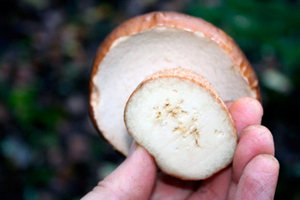 Also called “powdered flywheel”. Upper part small up to 5 cm, curved. The bright yellow hymenoflora instantly turns blue at the break. Leg height up to 7 cm, yellow with red-brown plaque dots, does not exceed 2 cm in width, the trama (fleshy part) is brown-yellow, turning blue when broken. It grows mainly on sandstones from June to September.
Also called “powdered flywheel”. Upper part small up to 5 cm, curved. The bright yellow hymenoflora instantly turns blue at the break. Leg height up to 7 cm, yellow with red-brown plaque dots, does not exceed 2 cm in width, the trama (fleshy part) is brown-yellow, turning blue when broken. It grows mainly on sandstones from June to September.
Bronze
 The upper part is from 7 to 17 cm in diameter, knocked down, at first convex, flattening as it develops. The outer layer is smooth, gradually straightening at the edges, and over time, notches and depressions appear on it. The surface layer is not covered with mucus.
The upper part is from 7 to 17 cm in diameter, knocked down, at first convex, flattening as it develops. The outer layer is smooth, gradually straightening at the edges, and over time, notches and depressions appear on it. The surface layer is not covered with mucus.
The hymenoflor, attached to the stem, is whitish, light gray, then changes to pale yellowish, cream and olive-yellow with a brownish tint; when pressed, it darkens rather than turns blue. The lower part is elongated, rounded, thickening downward.
This species grows in deciduous forests from Spain to Western Ukraine, Sweden, and North America.
Rooted
It also has other designations:

Due to its bitter taste, it is inedible, although not poisonous. The top reaches 20 cm, has the shape of a hemisphere, turning into a pillow-shaped one; the folded edges straighten as they grow. The tubes of depressed hymenoflora are lemon-yellow, turning blue when cut. The supporting part reaches 8 cm in length, 5 cm in diameter, resembles a tuber in appearance, and stretches out with age, leaving a thickening only at the bottom.
Prefers the warmth of deciduous forests, forms mycorrhiza (symbiosis) with oak and birch.
Pine
 The same boletus. The color of the crown varies from white, dark red to yellow and brown. It itself reaches 30 cm, rarely – 50 cm. The lower part grows to 16 cm.
The same boletus. The color of the crown varies from white, dark red to yellow and brown. It itself reaches 30 cm, rarely – 50 cm. The lower part grows to 16 cm.
This representative forms mycorrhiza with pine, spruce, as well as beech, chestnut, and hornbeam. Prefers sandstones, bears fruit in groups from mid-June to mid-October, sometimes after the first frost.
Reticulate
 Also called oak tree. The defining feature is a clear mesh along the entire short leg. It has a large velvety straw-ochre, whitish-cream with the possible presence of small cracks and scales in the center of a hat 5-15 cm, sometimes 20 cm in diameter, as if worn on a thick stocky leg.
Also called oak tree. The defining feature is a clear mesh along the entire short leg. It has a large velvety straw-ochre, whitish-cream with the possible presence of small cracks and scales in the center of a hat 5-15 cm, sometimes 20 cm in diameter, as if worn on a thick stocky leg.
The ocher color of the hymenophore intensifies with age, reaching a dirty olive color. The leg injury may be red. Although it contains toxic substances, the mushroom is edible, since they are destroyed during heat treatment, but combined use with alcohol is not recommended. Grows in the mountains of the Caucasus and Crimea.
Woody
 Woody, or birch, grows in forests mixed with this tree. The top is light brown, brownish or sandy. The leg is at first thick, ovoid, then elongated, thickening downward. Large specimens may resemble boletus mushrooms.
Woody, or birch, grows in forests mixed with this tree. The top is light brown, brownish or sandy. The leg is at first thick, ovoid, then elongated, thickening downward. Large specimens may resemble boletus mushrooms.
Rose gold
 Poisonous. Context (or trama) is yellow, fleshy, tasteless and odorless, turns blue when cut. The leg is first ovoid, then club-shaped, from 5 to 12 cm in height and 3-5 cm in thickness, covered with a mesh. The cap is yellow-brown, slightly pink or reddish; velvety, dry, matte and darkening over time.
Poisonous. Context (or trama) is yellow, fleshy, tasteless and odorless, turns blue when cut. The leg is first ovoid, then club-shaped, from 5 to 12 cm in height and 3-5 cm in thickness, covered with a mesh. The cap is yellow-brown, slightly pink or reddish; velvety, dry, matte and darkening over time.
Polish
 Also called: moss, chestnut, pansky, brown. The crown, measuring from 5 to 15 cm in diameter, resembles a chestnut in color and shape, round and brown, although reddish tones are also possible. The tubes are initially whitish, turning olive-yellow and turning blue when pressed. The whitish or yellowish trama turns blue when cut, has a pleasant aroma and a slight sour taste.
Also called: moss, chestnut, pansky, brown. The crown, measuring from 5 to 15 cm in diameter, resembles a chestnut in color and shape, round and brown, although reddish tones are also possible. The tubes are initially whitish, turning olive-yellow and turning blue when pressed. The whitish or yellowish trama turns blue when cut, has a pleasant aroma and a slight sour taste.
How to look for porcini mushrooms
 If you don’t know how to look for porcini mushrooms in the forest, pay attention to the soil: sandstones, sandy loams and loams; they “choose” this kind of soil, avoiding peat bogs and swamps. Their neighbors are pine, Siberian cedar, birch, beech, and hornbeam. Moreover, the age of coniferous trees must exceed 50 years, and deciduous trees 25.
If you don’t know how to look for porcini mushrooms in the forest, pay attention to the soil: sandstones, sandy loams and loams; they “choose” this kind of soil, avoiding peat bogs and swamps. Their neighbors are pine, Siberian cedar, birch, beech, and hornbeam. Moreover, the age of coniferous trees must exceed 50 years, and deciduous trees 25.
Growth most often occurs “in families” from 5 to 40 pieces not far from each other. But not only the trees with which they create symbiosis can indicate the possible location of these fruits. Frequent neighbors of porcini mushrooms:
- red fly agarics;
- morels;
- anthills;
- white grass
If the summer is wet, then boletus mushrooms can be found on warm and dry hills, clearings, edges, and when there is no rain - under trees in thick grass. Until what month can you pick porcini mushrooms? Usually from mid-June to the end of September.
When the difference between day and night temperatures is significant, the weather is rainy, mushrooms grow poorly. At what temperature should you look for them? Optimal – from +15°C to +20°C with low humidity.
How quickly does porcini mushroom grow after rain? The day after rain (not a downpour or a lingering cold one) development begins. It is important that the mycelium, located at a depth of 5-10 cm, is well moistened. And then, from about 5 days, the firstborns appear against the background of warm temperatures.
How long does it take for porcini mushroom to grow? It usually grows to medium size in 5 days and then continues to grow for about 2 more weeks.
Beneficial properties of porcini mushroom
This mushroom is loved not only for amazing taste. Its beneficial properties of porcini mushroom allow it to be used for the prevention and treatment of certain diseases. Borovik:
- has an antitumor effect;
- activates the production of gastric juice better than broths from meat;
- is a barrier against cholesterol deposition on the walls of blood vessels;
- the amino acid ergothioneine is very important for vision and internal organs;
- helps in the treatment of frostbite;
- supports the body during angina pectoris;
- source of proteins;
- partially prevents neoplasia;
- increases vitality.
Dangerous doubles of porcini mushroom
False mushrooms can be found in the same places as edible ones. They also grow in groups, sometimes in large numbers next to the real ones, which is where the danger lies.
Gall mushroom or mustard
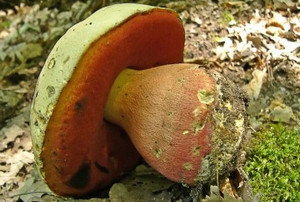 This dangerous double The porcini mushroom belongs to the genus Tilopilus and looks very similar to the boletus mushroom. Grows on heated sandstones, loams, fertilized with fallen pine needles. Outwardly, it resembles a young oak tree, but the hymenoflor is colored pink, often visible only at the break, or a dirty white hue.
This dangerous double The porcini mushroom belongs to the genus Tilopilus and looks very similar to the boletus mushroom. Grows on heated sandstones, loams, fertilized with fallen pine needles. Outwardly, it resembles a young oak tree, but the hymenoflor is colored pink, often visible only at the break, or a dirty white hue.
How to distinguish a false white mushroom from a real one? The difference is the bitter taste, which intensifies when heat treatment. When pickling, the bitterness is overcome by vinegar; when soaked, it disappears. However, it is not recommended to eat it due to the content of toxic substances that settle in the liver and can cause cirrhosis. Toxins easily penetrate the bloodstream through tactile contact or a bitterness test.
Satanic mushroom
 Another dangerous double from the Bolet family. It grows on limestone soils in forests with linden, oak, beech, hazel, and chestnut, forming a symbiosis with them. The crown of the inedible boletus is flatter in shape, 10-20 cm, dry, dense, buffy-pale. The context is white, slightly bluish at the break. The barrel-shaped lower part reaches 10 cm in height and 6 cm in width, has red shades in the crown zone.
Another dangerous double from the Bolet family. It grows on limestone soils in forests with linden, oak, beech, hazel, and chestnut, forming a symbiosis with them. The crown of the inedible boletus is flatter in shape, 10-20 cm, dry, dense, buffy-pale. The context is white, slightly bluish at the break. The barrel-shaped lower part reaches 10 cm in height and 6 cm in width, has red shades in the crown zone.
This specimen is poisonous or conditionally edible, since the toxicity disappears after ten hours of soaking and subsequent heat treatment, without which consumption leads to severe poisoning or deaths.



